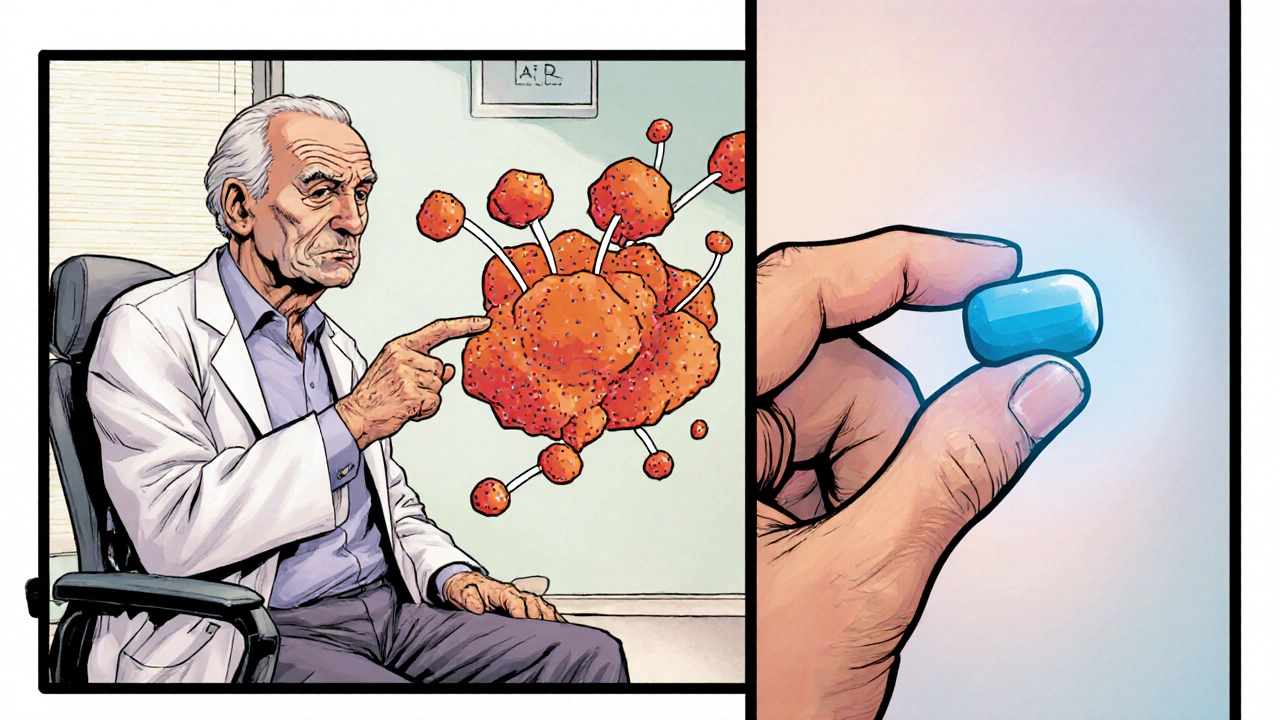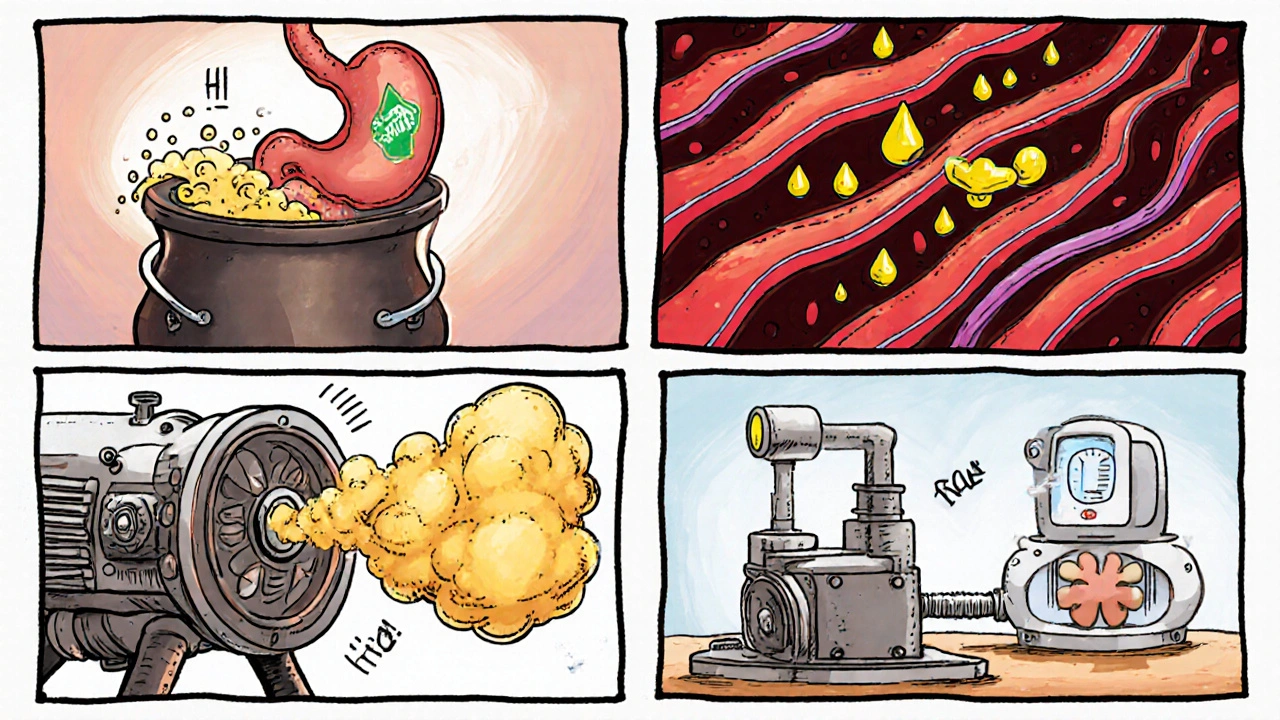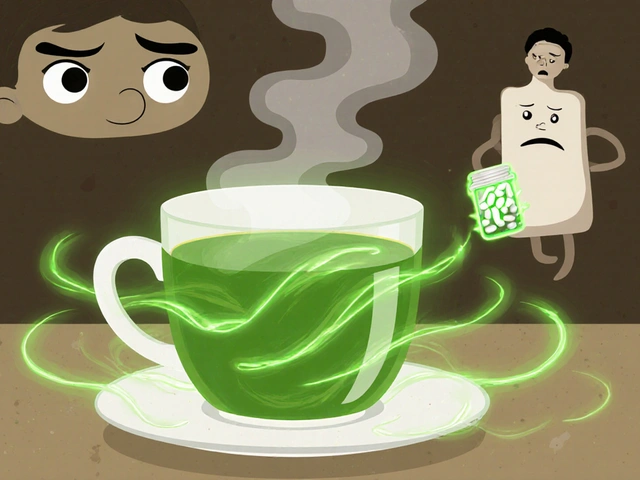Dasatinib and the Elderly: Key Considerations for Older Patients

Dasatinib Dose Calculator for Older Adults
Dosage Calculator
Recommended Dosage
More than 20% of new chronic myeloid leukemia (CML) diagnoses now occur in people over 70, and the same generation is living longer with the disease. That shift forces clinicians to ask a simple but crucial question: how does a drug like Dasatinib a second‑generation BCR‑ABL tyrosine‑kinase inhibitor used to treat CML behave in an aging body?
Why Dasatinib is Different from First‑Generation Options
Dasatinib targets the BCR‑ABL tyrosine kinase the abnormal enzyme that drives CML cell growth more potently than the first‑generation drug Imatinib the original CML therapy approved in 2001. The stronger inhibition translates into faster molecular responses, but it also means a tighter therapeutic window-especially for older patients whose organ function and drug‑handling capacity are changing.
Age‑Related Pharmacokinetic Changes
When you hit 65, several physiological shifts start to matter:
- Reduced gastric acidity can slow drug absorption.
- Body water declines while fat percentage climbs, altering the distribution of lipophilic agents like Dasatinib.
- Liver blood flow drops, potentially decreasing the activity of CYP3A4 the main enzyme that metabolizes Dasatinib.
- Renal clearance falls about 1% per year after 40, meaning even a drug cleared largely by the liver can accumulate if kidney function is borderline.
These changes don’t happen in a vacuum; they intersect with common comorbidities found in seniors.
Common Comorbidities That Influence Dasatinib Therapy
Older adults often live with conditions that directly affect both safety and efficacy. Below are the three most frequent:
- Cardiovascular disease including hypertension, coronary artery disease, and heart failure. Dasatinib can cause fluid retention and pulmonary hypertension, so baseline cardiac evaluation is a must.
- Renal impairment a decrease in glomerular filtration rate (GFR) that becomes more common with age. Even mild impairment (GFR 45‑60mL/min) may require dose reduction.
- Polypharmacy the simultaneous use of five or more medications, typical in seniors. This raises the odds of drug-drug interactions, especially with CYP3A4 inhibitors or inducers.
Practical Dose‑Adjustment Guidelines
Below is a quick reference that blends age, renal function, and cardiac status into actionable dosing suggestions. The table follows the latest NCCN 2025 recommendations for patients aged≥65.
| Patient Profile | Standard Dose | Adjusted Dose | Monitoring Frequency |
|---|---|---|---|
| Normal renal function (eGFR ≥60mL/min) & no cardiac issues | 100mg once daily | None | CBC and electrocardiogram (ECG) every 4weeks |
| eGFR 45‑59mL/min or mild cardiac disease | 100mg once daily | Reduce to 70mg once daily | CBC and ECG every 2weeks for first 2months, then monthly |
| eGFR <45mL/min or moderate/severe cardiac disease | 100mg once daily | Reduce to 50mg once daily | CBC, ECG, and echocardiogram every 2weeks for first 6weeks, then monthly |
| Concurrent strong CYP3A4 inhibitor (e.g., ketoconazole) | 100mg once daily | Reduce to 50mg once daily regardless of renal function | Therapeutic drug monitoring (if available) + CBC weekly for first month |
Dasatinib elderly patients should never start at a reduced dose without documented reason-under‑dosing can let the disease rebound, while over‑dosing opens the door to serious toxicities.

Key Safety Checks Before and During Treatment
Every older patient should go through the same core safety checklist, but the emphasis shifts slightly toward organ‑function surveillance.
- Baseline labs: Complete blood count (CBC), liver enzymes (ALT/AST), serum creatinine, and electrolytes.
- Cardiac work‑up: ECG to spot QT prolongation, echocardiogram if there’s a history of heart failure, and blood pressure measurement.
- Medication review: Look for concurrent CYP3A4 substrates, inhibitors, or inducers that could alter Dasatinib levels. Common culprits include azole antifungals, certain calcium‑channel blockers, and grapefruit juice.
- Adherence assessment: Simple pill‑box reminders or weekly phone checks can bridge the gap caused by memory lapses.
Once therapy starts, repeat labs and ECGs on the schedule shown in the table above. Any sign of severe cytopenia, pleural effusion, or sudden dyspnea should trigger an immediate dose hold and a physician call.
Managing Common Side Effects in Seniors
Side effects are the main driver of discontinuation. Below are the three you’ll see most often, along with senior‑friendly coping tips.
| Toxicity | Typical Onset | Management Strategy |
|---|---|---|
| Pleural effusion | Weeks‑to‑months | Chest X‑ray at first symptom, diuretics if fluid‑retentive, consider dose reduction to 70mg. |
| Cytopenias (low platelets, neutrophils) | First 2‑3months | Hold drug until counts recover, then restart at 50mg. |
| Myalgia/arthralgia | Any time | Acetaminophen, gentle stretching, evaluate for concurrent statin therapy. |
Older adults often report “feeling weak” rather than specific lab changes. Encourage them to call the clinic whenever energy dips, even if labs look fine.
Drug‑Interaction Pitfalls to Watch
Because Dasatinib is a CYP3A4 substrate, any medication that affects this enzyme can swing its blood levels.
- Inhibitors (↑ Dasatinib): Ketoconazole, ritonavir, clarithromycin. Either pause the interacting drug or halve Dasatinib.
- Inducers (↓ Dasatinib): Rifampin, carbamazepine, St. John’s wort. Either increase Dasatinib to 140mg (rare) or switch the inducer.
- Acid‑reducing agents: Proton‑pump inhibitors can lower absorption. Take Dasatinib with a full glass of water at least 30minutes before breakfast and separate from PPIs by at least 2hours.
A quick review of the patient’s pharmacy list can prevent many surprises.

Adherence Boosters for the Elderly
Even with perfect dosing, the best plan fails if pills aren’t taken.
- Use blister packs labeled with days of the week.
- Set a daily alarm on a phone or bedside clock.
- Engage a caregiver or family member for a weekly check‑in.
- Document any missed doses in a small notebook; discuss at each visit.
These low‑tech hacks often outperform high‑tech apps for patients over 80 who may not be smartphone‑savvy.
When to Consider Switching Therapies
Despite best efforts, some seniors will not tolerate Dasatinib. Knowing when to pivot is as important as the initial prescription.
- Two or more grade3‑4 toxicities despite dose reductions.
- Persistent pleural effusion requiring repeated thoracentesis.
- Inability to achieve major molecular response (MMR) after 12months on the maximum tolerated dose.
Alternative options include Nilotinib another second‑generation BCR‑ABL inhibitor with a different toxicity profile or the third‑generation drug Ponatinib effective against T315I mutation but carries higher vascular risk. The decision hinges on the patient’s organ health, lifestyle, and personal preferences.
Quick Checklist for Clinicians
- Confirm CML diagnosis and BCR‑ABL status.
- Obtain baseline CBC, liver panel, creatinine, ECG.
- Review full medication list for CYP3A4 interactions.
- Choose starting dose based on eGFR and cardiac status (see table).
- Schedule CBC and ECG at 4‑week intervals, then adjust frequency.
- Educate patient on dosing time, water intake, and side‑effect signs.
- Set up adherence support: blister pack, reminder system, caregiver check‑in.
- Re‑evaluate at 3months: molecular response, tolerance, quality of life.
Frequently Asked Questions
Can an 80‑year‑old safely start Dasatinib?
Yes, if kidney function is adequate (eGFR ≥45mL/min), cardiac disease is stable, and no strong CYP3A4 inhibitors are used. Start at 70mg or 50mg based on the table, then monitor closely.
What is the most common serious side effect in seniors?
Pleural effusion, which can cause shortness of breath. Early detection via chest X‑ray and prompt dose reduction usually prevents complications.
Do I need to stop a PPI while taking Dasatinib?
You don’t have to stop it, but schedule Dasatinib at least 30minutes before breakfast and separate from the PPI by 2hours to ensure proper absorption.
How often should I check the patient’s blood counts?
Every 4weeks for the first two months, then monthly if counts stay stable. Any grade3‑4 drop requires a hold and repeat CBC within a week.
Is Dasatinib covered by provincial drug plans for seniors?
Most provincial plans list Dasatinib under specialty drugs. Eligibility often depends on income and disease stage, so checking the specific formulary is essential.






Steve Holmes
October 16, 2025 AT 19:51Wow, the aging population really changes the game, especially when we talk about something as potent as Dasatinib, right?, The shift to more than 20% of CML diagnoses over 70 means clinicians have to rethink dosing, because the pharmacokinetics shift dramatically with age, you see, reduced gastric acidity can slow absorption, and the increase in body fat can alter distribution, plus the liver blood flow drops, which reduces CYP3A4 activity, and the kidneys get a bit slower too, all of that contributes to higher plasma levels, which can be a double‑edged sword, faster molecular responses are great, but the therapeutic window shrinks, especially for seniors with comorbidities, so the guidelines suggesting a reduction to 70 mg for mild renal impairment are actually lifesavers, we also have to watch for fluid retention and pulmonary hypertension, because those can be fatal in frail patients, regular CBCs and ECGs every few weeks are non‑negotiable, and if you catch a rise in liver enzymes early, you can adjust before damage, I’ve seen clinics that simply ignore these nuances and end up with higher toxicity rates, it’s basically a recipe for disaster, on the other hand, when you tailor the dose carefully and monitor closely, patients can enjoy a quality of life that was unimaginable a decade ago, so the key takeaway is to treat dasatinib not as a one‑size‑fits‑all drug but as a personalized therapy that respects the biology of aging, and that mindset will improve outcomes across the board.
RJ Samuel
October 20, 2025 AT 05:54Honestly, the whole hype around dasatinib for the elderly feels a bit overblown, the drug’s potency might just be a hidden trap for those over seventy, maybe we should stick with older, well‑studied options for safety’s sake.
Sara Werb
October 23, 2025 AT 15:57Can you believe they expect us to trust big pharma with our grandparents??? The whole system is rigged, they hide the side effects, they want us to swallow pills while they line their pockets, dasatinib might be a poison in disguise, especially when your liver is already tired, and don’t even get me started on the government colluding with the drug companies, they’ll say “monitor your labs” but the labs are just paper, you’re left battling fluid build‑up and breathing struggles, and all the while they push the “innovation” narrative, it’s a nightmare, the only safe route is to go back to basics, real medicine, not this high‑tech nightmare.
Emily Rankin
October 27, 2025 AT 00:59Imagine a world where age is not a barrier but a canvas for hope, where dasatinib becomes a bridge rather than a cliff, we can weave together the science of targeted therapy with the art of compassionate care, by listening to each patient’s story we discover the rhythm of their heart, we adjust the dose like a musician tuning an instrument, the result is a symphony of remission and vitality, even in the twilight years, the journey isn’t just about numbers on a chart but about rediscovering the joys of a sunrise, a laugh with grandchildren, a walk without breathlessness, this perspective turns a potent drug into a partner in life’s adventure, let’s embrace it with careful optimism.
Rebecca Mitchell
October 30, 2025 AT 11:02Mitchell says dose tweaks matter a lot.
Roberta Makaravage
November 2, 2025 AT 21:05😇 Absolutely, the safety profile demands respect, we must not forget the ethical responsibility, clinicians should prioritize patient welfare above all, dose reductions are not just recommendations, they’re essential safeguards, always remember the moral imperative.
Patricia Echegaray
November 6, 2025 AT 07:08While the patriotic duty to protect our elders is paramount, one cannot ignore the shadowy alliances that sometimes dictate dosage norms, the intricate dance between regulation and profit can mask true risk, therefore a vigilant, critical eye is indispensable, and a balanced discourse must include both scientific rigor and an awareness of hidden agendas.
Katie Henry
November 9, 2025 AT 17:10Esteemed colleagues, I implore you to consider the profound impact of judicious dose modulation, for it is through disciplined adherence to evidence‑based protocols that we empower our senior patients to thrive, let us champion meticulous monitoring and unwavering dedication to optimal therapeutic outcomes.
Joanna Mensch
November 13, 2025 AT 03:13The hidden mechanisms behind dasatinib metabolism are often concealed, secret pathways may alter drug levels without our notice, this covert influence warrants cautious vigilance.
Nickolas Mark Ewald
November 16, 2025 AT 13:16Indeed, careful monitoring can catch those hidden changes and keep treatment safe.
Chris Beck
November 19, 2025 AT 23:19Dasatinib works but older patients need adjustments it can cause issues if not managed properly.
Winston Bar
November 23, 2025 AT 09:21Typical boilerplate advice, nothing new, just the same old warnings repeated for the hundredth time.
Russell Abelido
November 26, 2025 AT 19:24It’s heartbreaking to see seniors grapple with the side effects, yet the promise of faster remission shines through like a beacon, we must stand beside them, listening to their fears, adjusting doses with compassion, and celebrating each small victory, because every extra breath of freedom is a triumph over the disease, 🌟
Tom Green
November 30, 2025 AT 05:27Remember, shared knowledge and patient education are the cornerstone of effective therapy; guide them through each step with patience and clarity.
Lauren Sproule
December 3, 2025 AT 15:30We all wanna see them do well, so keeping the convo open and supportive helps a lot
CHIRAG AGARWAL
December 7, 2025 AT 01:32Listen up, I’ve read countless studies and let me tell you the best way to handle dasatinib in the elderly is to start low and watch the labs closely, don’t ignore the signs.
genevieve gaudet
December 10, 2025 AT 11:35ay, the journey of aging with a strong drug like dasatinib is kinda like a cultural rite, we blend science with the stories of our elders, honoring both the data and the lived experience.